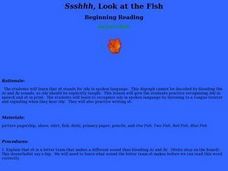Resources for Educators
Math & Science Connection
Whether you're using a collection of Dr. Seuss books to teach basic math skills like counting, adding, and subtracting, or exploring the different states of matter by melting a crayon with a hairdryer, a series of 11 fun activities...
Curated OER
Brain Teaser - Fish Story
In this logic worksheet, students solve a word problem using logic about each person having an animal and only 1 having a fish. Students complete 1 problem.
Curated OER
Ratio and Proportion Problems
What is ratio? What is proportion? Two examples are shown before your pupils are given seven problems using either ratio or proportion. Consider having your learners illustrate a selection of the problems provided.
Curated OER
Fish: Sponge Painting Art
In this painting activity, students follow the directions on this page to create a picture of a fish. Students use sponge paints and a cardboard comb with paint to make a fish, which will be cut out after it is dry.
Curated OER
Dr. Seuss: "Old Fish, New Fish"
In this Dr. Seuss instructional activity, students find opposites of fish from the story One Fish Two Fish...drawing lines to the opposites of pictures given. A website reference is given for additional resources.
Curated OER
Reproductive Lottery
Students explain that fishes that reproduce externally have to release great numbers of eggs and milt (sperm) in order to ensure fertilization.
Curated OER
Shhhhhhhh!!!!!
Students recognize and practice putting certain letters together as they make unique sounds in one mouth movement. This lesson plan focuses on the digraph /sh/. They study and recite the tongue twister "Shelly's aunt, Sharon shears...
Curated OER
Indirect Length Word Problems
Word problems are a wonderful way to connect math and the real world. However, I've never seen a 12 centimeter-long apple tree. Aside from some odd word choices, this worksheet provides children with ten problems to solve by determining...
Curated OER
Dr. Seuss Books Crossword
In this Dr. Seuss worksheet, learners use a set of 14 clues to complete a Dr. Seuss book title worksheet. Answers are given on page 2.
Curated OER
Using Addends and Sum/Using Subtrahend, Minuend, and Difference
What is an addend? What is a sum? Review this math terminology on the top half of the worksheet before practicing basic addition.
Curated OER
I Like to Shuffle Along in My Shiny Shoes
Young scholars study the letters s and h as they blend together to make one sound. They practice making the sound, reciting a tongue twister while stretching the sh sound, and writing the letters. Next, they make words using letter boxes...
Curated OER
Compound Sentences
In this compound sentences instructional activity, 3rd graders combine two sentence using the word "and". In this short answer instructional activity, students write four sentences.
Curated OER
Problem Solving with Addition and Subtraction: Post Test
In this addition and subtraction worksheet, students answer multiple choice questions where they solve word problems using 2 and 3 digit numbers. Students complete 10 questions total.
Curated OER
Reading: The Food Pyramid
In this reading comprehension worksheet, students read a one page text about the food pyramid. Students then complete 8 sentences with the correct words from 2 choices.
Curated OER
Yellowish Fish
Students engage in an emergent literacy lesson in order to obtain the skill of phoneme awareness to become better readers. They practice blending different phonemes in order to eventually form words.
Curated OER
Ssshhh, Look at the Fish
Learn that "sh" stands for /sh/ in spoken language. This digraph cannot be decoded by blending the /s/ and /h/ sounds, so /sh/ should be explicitly taught. This lesson gives the students practice recognizing /sh/ in speech and "sh" in...
Nosapo
Writing about a Meal
You don't need to be a food critic to describe your meal accurately! A series of activities introduce learners to vivid adjectives when writing about the taste, smell, and feel of food. After working with word choice, parts of a...
NOAA
Methane Hydrates – What's the Big Deal?
Have you ever tried to light ice on fire? With methane hydrate, you can do exactly that. The ice forms with methane inside so it looks like ice, but is able to burn. The lesson uses group research and a hands-on activity to help scholars...
Curated OER
Now You See Me, Now You Don't
Bioluminescence fascinates most upper elementary scientists. Display images of different glowing deep-sea organisms and discuss their environment. Young biologists then experiment with images and different colors of filtered light. In...
Curated OER
The Fish Say Shhh
First graders identify the digraph /sh/ in written and spoken language. Students practice the production of the /sh/ sound through tongue twisters and riddles. They identify the initial and final placement of the new digraph /sh/ using a...
Curated OER
Swimmy's Friends
Students solve problems using various strategies. In this problem solving lesson, students read the book Swimmy by Leo Lionni. Students make fish swimming patterns, measure how many goldfish crackers it takes to make a handprint and...
Curated OER
Respect, Cooperation
First graders listen to the Rainbow Fish and sing the song We Are Crayons and list. In this respect and cooperation lesson, 1st graders answer questions about things that make them special. Students write something that makes them unique...
Curated OER
Animal Classification
Third graders differentiate between vertebrates and invertebrates, and identify the main characteristics of mammals, fish, reptiles, amphibians, and birds. They sort and categorize different types of balls, discuss the characteristics...
Curated OER
Oh, Let the Rain Fall Down
Fifth graders explain the three phases of the water cycle in a narraive paragraph where they describe the journey of a single raindrop. They are introduced to five science vocabulary words and personfication.

























